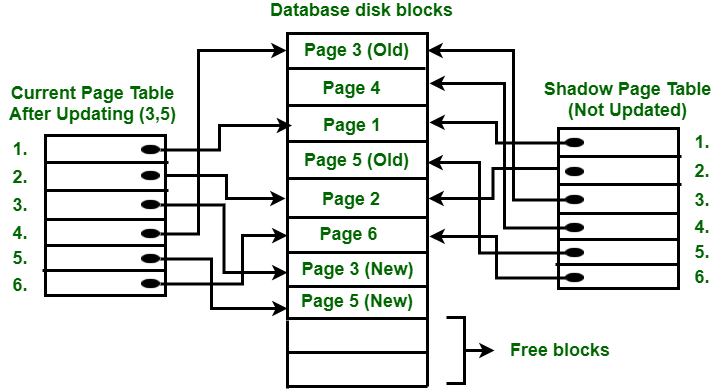🧠 DBMS Recovery and Types of Failures
✅ What is Recovery?
In DBMS, recovery means bringing the database back to a consistent and correct state
after a failure like a system crash or power failure.
It ensures:
- Atomicity: All steps of a transaction are completed or none.
- Durability: Once a transaction is committed, its changes stay even after a
crash.
Recovery uses techniques like undo (to cancel incomplete changes) and
redo (to reapply completed ones).
🧨 1. Types of Failures – Real-Life Examples
🔸 a. Transaction Failure
One transaction fails but others continue.
Example: While transferring money from A to B, power goes off. Money is deducted
from A but not added to B.
🔸 b. System Crash
The whole system crashes due to power cut or OS failure.
Example: Multiple users are using the database, but system suddenly shuts down. Some
data is lost.
🔸 c. Disk Failure
Database files on the disk are physically damaged.
Example: The disk storing customer records is corrupted and can’t be read.
🔁What is Undo and Redo in DBMS?
| Action |
Meaning |
When Used |
| UNDO |
Cancel the changes of incomplete transactions |
If a transaction was not committed before the crash |
| REDO |
Re-apply the changes of completed transactions |
If a committed transaction's changes were not saved to disk |
🎯Simple Example for Undo and Redo
Let's say account A = ₹1000, B = ₹500.
Case: Transaction T1
T1 transfers ₹200 from A to B
<START T1>
<T1, A, 1000, 800>
<T1, B, 500, 700>
<COMMIT T1>
If system crashes after this log is written but before data is saved:
- ✅ T1 is committed ⇒ Apply REDO
- Result after recovery: A = 800, B = 700
Case: Transaction T2
T2 tries to transfer ₹300 from A to C
<START T2>
<T2, A, 800, 500>
**(Crash here)**
Since T2 is not committed, we use UNDO
📘Log-Based Recovery (Detailed)
DBMS stores every change into a log file before applying it to the actual database.
This helps in recovery.
🔸Log Entry Format
<Transaction ID, Data Item, Old Value, New Value>
✅ Example:
<T1, A, 100, 200>
→ means T1 changed A from 100 to 200
✅Checkpoint in DBMS
📘What is Checkpoint?
Checkpoint is a safe point saved by DBMS.
It means: "All changes before this are safely saved on disk."
This reduces recovery time after crash.
✅Example with Checkpoint
Let's say we have the following log:
<START T1>
<T1, A, 100, 150>
<COMMIT T1>
<START T2>
<T2, B, 200, 300>
<CHECKPOINT>
<T2, B, 300, 400>
<T2, C, 400, 500>
<START T3>
<T3, A, 150, 180>
<CRASH>
💥Crash Happens Now. What to do?
➡️ After crash, DBMS checks the log and the last checkpoint.
At checkpoint:
- T1 is committed → ✅ No need to process
- T2 and T3 are active → DBMS checks them
🧠Recovery Actions:
| Transaction |
Status |
Action |
| T1 |
Committed before checkpoint |
Nothing to do |
| T2 |
Not committed |
❌ Undo |
| T3 |
Not committed |
❌ Undo |
🪞Shadow Paging (Alternative to Logs)
💡Idea: Work on a duplicate version until done

🔸Real-life Example:
You write an article. Instead of editing the original, you edit a copy. If all
edits are good, you replace the original. If not, discard the copy.
🌗Shadow Paging in DBMS
- Shadow Page Table: Original data (never touched)
- Current Page Table: Used during transaction
- If commit: Copy current to shadow
- If crash: Discard current and use shadow
🔸Example:
Let's say:
- A = ₹100
- Transaction changes A to ₹200
3
Crash before commit → Discard current
4
Final value = 100 ✅ (safe)
🔄Recovery Phases in DBMS
After crash, recovery goes in these steps:
1
Analysis Phase
→ Find which transactions were active during crash.
2
Redo Phase
→ Reapply changes of committed transactions.
3
Undo Phase
→ Rollback changes of uncommitted transactions.
🧾FULL FINAL EXAMPLE: COMBINING ALL
Situation: Three transactions
Initial Values:
Log File:
<START T1>
<T1, A, 100, 150>
<T1, B, 200, 250>
<COMMIT T1>
<START T2>
<T2, C, 300, 350>
<CHECKPOINT>
<T2, C, 350, 400>
<START T3>
<T3, A, 150, 180>
<CRASH>
Now Recovery Happens
| Transaction |
Status |
Action |
| T1 |
Committed |
✅ REDO |
| T2 |
Not committed |
❌ UNDO |
| T3 |
Not committed |
❌ UNDO |
Final Values after Recovery:
- A = 150 (from T1 REDO)
- B = 250 (from T1 REDO)
- C = 300 (T2 undone)
✅ Safe, consistent data.
📌Summary
🔄Undo
Meaning: Cancel uncommitted changes
Use: Recover from crash
🔄Redo
Meaning: Reapply committed changes
Use: Ensure durability
✅Checkpoint
Meaning: Safe save point
Use: Faster recovery
🪞Shadow Paging
Meaning: Copy-modify method
Use: Simple recovery, no logs
📘Log File
Meaning: History of all actions
Use: Used for recovery
🔄Recovery Phases
Meaning: Analyze → Redo → Undo
Use: Full process
